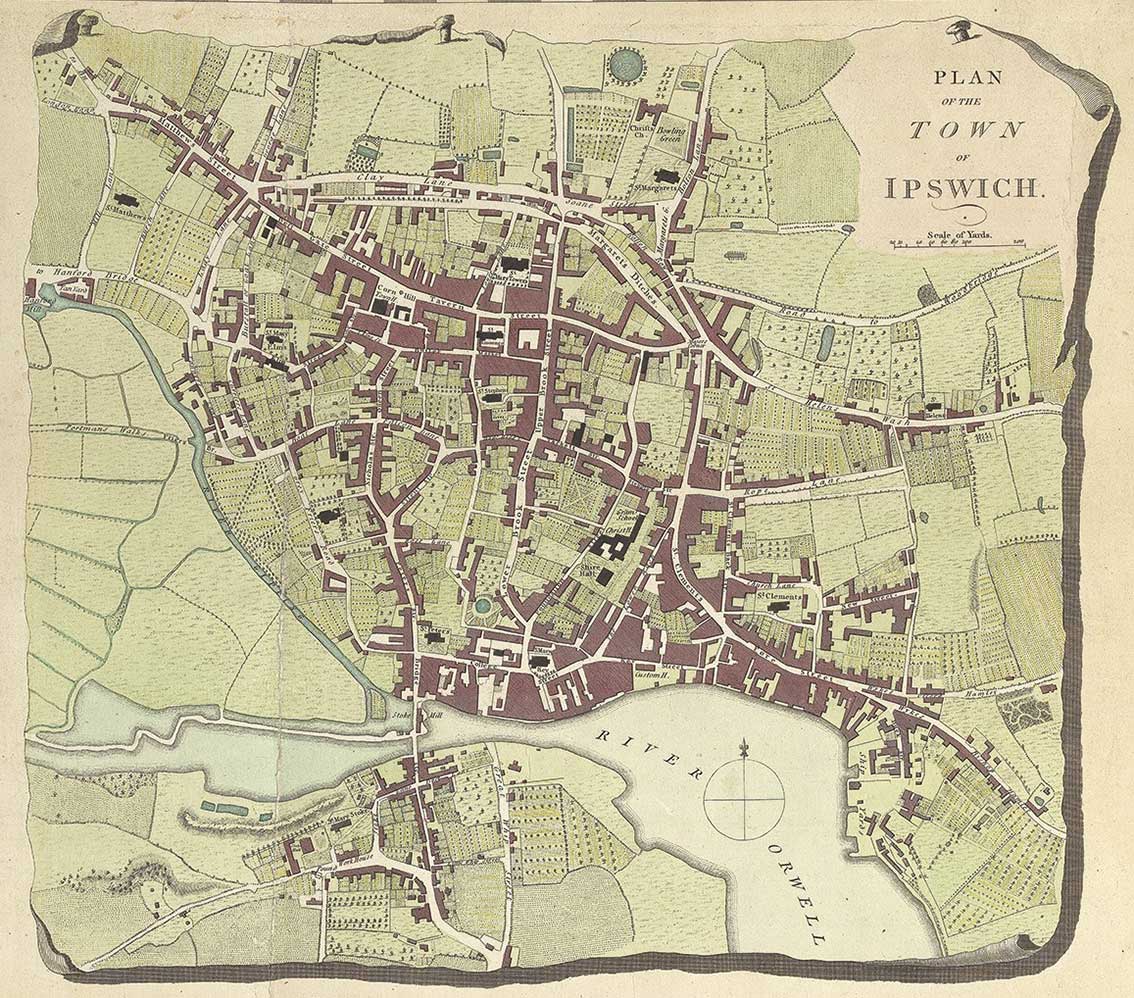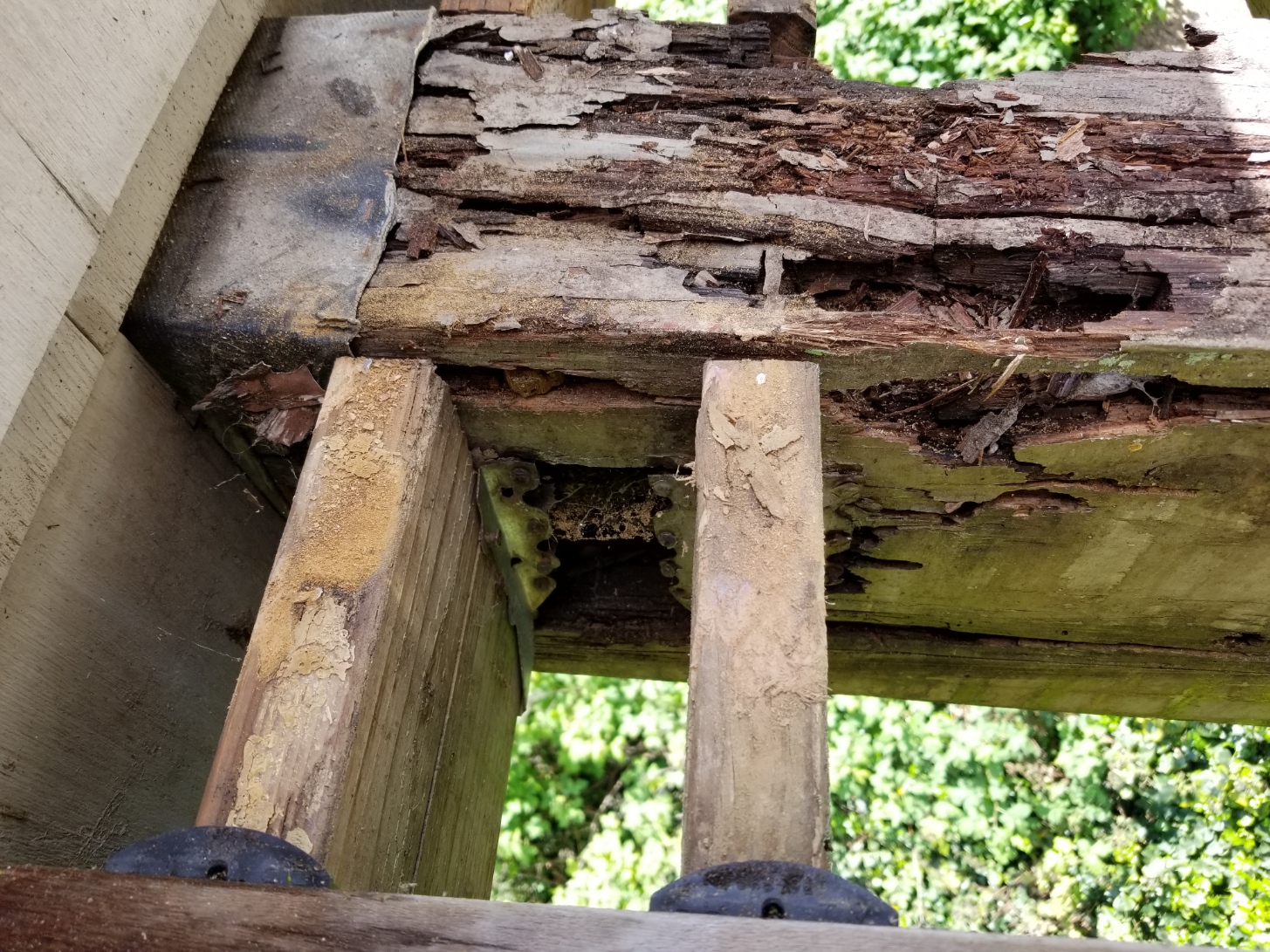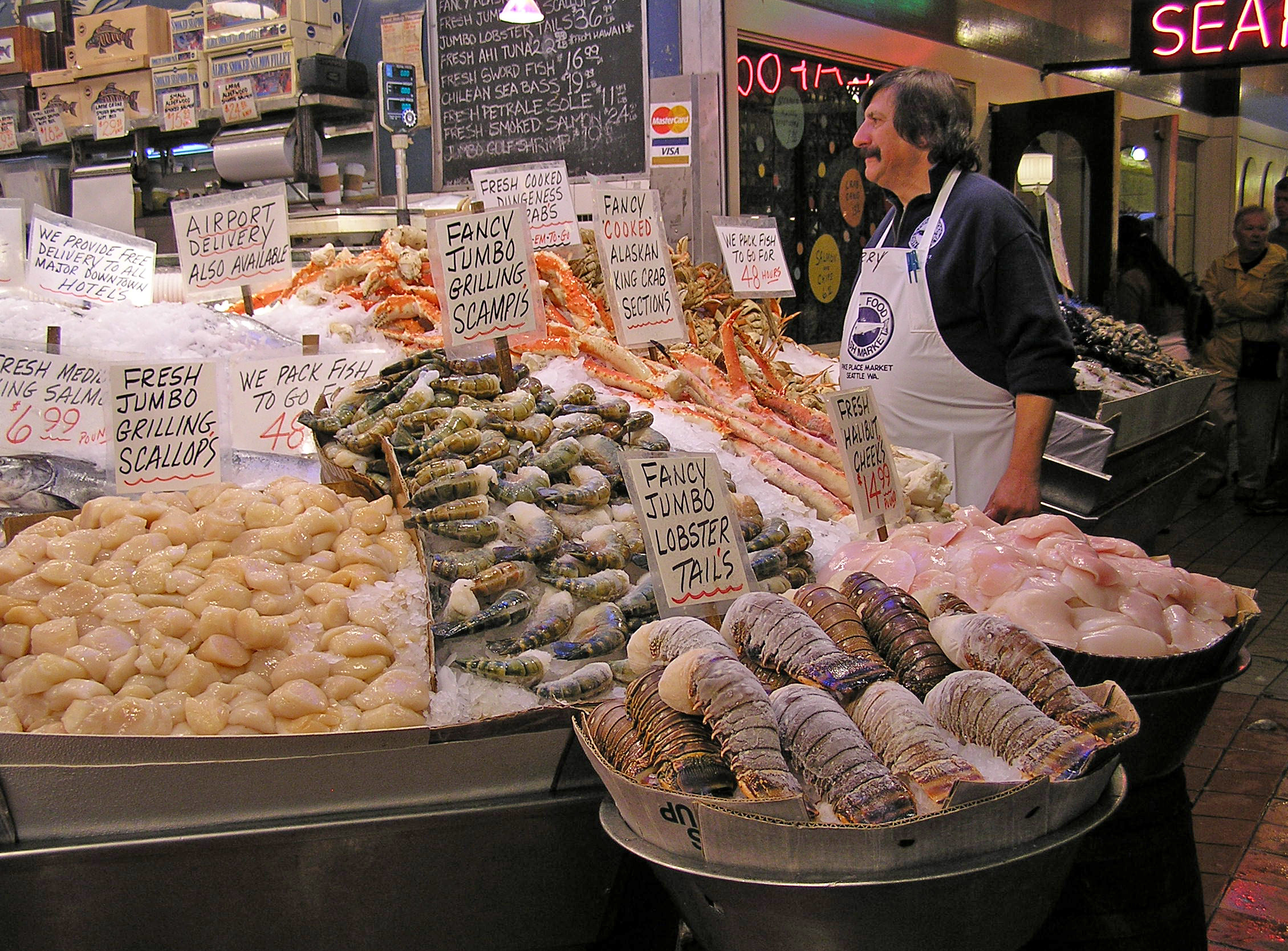|
Ancient House, Ipswich
The Ancient House, also known as Sparrowe's House, is a Grade I listed building dating from the 15th century located in the Buttermarket area of Ipswich, Suffolk, England. In 1980 the building was acquired by Ipswich Borough Council. The building sports detailed pargeting, and also elaborate wood carvings around the front of the house. Four panels of pargeting show a Tudor impression of the world. The continents Africa, America, Asia and Europe are shown—notably lacking Australia, which had not been discovered at the time. Africa is represented by a naked man holding a spear, Asia by a horse and a mosque-like building, Europe by a woman with a horse and a church-like building, and America by a man with a dog at his feet. The building features the Ipswich window. The front of the building as it can be seen today (in a restored state), was not an original feature—it was added by Robert Sparrowe between 1660 and 1670. It bears the Royal Arms of King Charles II, and the wor ... [...More Info...] [...Related Items...] OR: [Wikipedia] [Google] [Baidu] |
Ipswich Ancient House
Ipswich () is a port town and borough in Suffolk, England, of which it is the county town. The town is located in East Anglia about away from the mouth of the River Orwell and the North Sea. Ipswich is both on the Great Eastern Main Line railway and the A12 road; it is north-east of London, east-southeast of Cambridge and south of Norwich. Ipswich is surrounded by two Areas of Outstanding Natural Beauty (AONB): Suffolk Coast and Heaths and Dedham Vale. Ipswich's modern name is derived from the medieval name ''Gippeswic'', probably taken either from an Anglo-Saxon personal name or from an earlier name given to the Orwell Estuary (although possibly unrelated to the name of the River Gipping). It has also been known as ''Gyppewicus'' and ''Yppswyche''. The town has been continuously occupied since the Saxon period, and is contested to be one of the oldest towns in the United Kingdom.Hills, Catherine"England's Oldest Town" Retrieved 2 August 2015. Ipswich was a settlement of ... [...More Info...] [...Related Items...] OR: [Wikipedia] [Google] [Baidu] |
Martlesham
Martlesham is a village in Suffolk, England about two miles (3 km) South-West of Woodbridge and East of Ipswich. It is often referred to as "old Martlesham" by locals in order to distinguish this old village from the much more recent Martlesham Heath development (1 km) to the south although both form a single administrative parish. Also at Martlesham Heath is BT's Research and Development Centre, now called Adastral Park. Martlesham was recorded in Domesday Book as ''Merlesham''. The history and meaning of the name are studied in a paper by Briggs. It probably means 'settlement (''hām'') near the mooring-place (''mǣrels'')'. History of Martlesham It is believed that there was a Roman settlement at Martlesham and in the parish there have been some 26 finds dating from the Roman occupation. These include pottery, brooches, coins and tesserae. Of particular note was the 19th century find of a small bronze statue of a horse on a plinth, bearing a Latin inscription ind ... [...More Info...] [...Related Items...] OR: [Wikipedia] [Google] [Baidu] |
Houses Completed In The 15th Century
A house is a single-unit residential building. It may range in complexity from a rudimentary hut to a complex structure of wood, masonry, concrete or other material, outfitted with plumbing, electrical, and heating, ventilation, and air conditioning systems.Schoenauer, Norbert (2000). ''6,000 Years of Housing'' (rev. ed.) (New York: W.W. Norton & Company). Houses use a range of different roofing systems to keep precipitation such as rain from getting into the dwelling space. Houses may have doors or locks to secure the dwelling space and protect its inhabitants and contents from burglars or other trespassers. Most conventional modern houses in Western cultures will contain one or more bedrooms and bathrooms, a kitchen or cooking area, and a living room. A house may have a separate dining room, or the eating area may be integrated into another room. Some large houses in North America have a recreation room. In traditional agriculture-oriented societies, domestic animals suc ... [...More Info...] [...Related Items...] OR: [Wikipedia] [Google] [Baidu] |
List Of Grade I Listed Buildings In Ipswich
A ''list'' is any set of items in a row. List or lists may also refer to: People * List (surname) Organizations * List College, an undergraduate division of the Jewish Theological Seminary of America * SC Germania List, German rugby union club Other uses * Angle of list, the leaning to either port or starboard of a ship * List (information), an ordered collection of pieces of information ** List (abstract data type), a method to organize data in computer science * List on Sylt, previously called List, the northernmost village in Germany, on the island of Sylt * ''List'', an alternative term for ''roll'' in flight dynamics * To ''list'' a building, etc., in the UK it means to designate it a listed building that may not be altered without permission * Lists (jousting), the barriers used to designate the tournament area where medieval knights jousted * ''The Book of Lists'', an American series of books with unusual lists See also * The List (other) * Listing (di ... [...More Info...] [...Related Items...] OR: [Wikipedia] [Google] [Baidu] |
Deathwatch Beetle
The deathwatch beetle (''Xestobium rufovillosum'') is a species of woodboring beetle that sometimes infests the structural timbers of old buildings. The adult beetle is brown and measures on average long. Eggs are laid in dark crevices in old wood inside buildings, trees, and inside tunnels left behind by previous larvae. The larvae bore into the timber, feeding for up to ten years before pupating, and later emerging from the wood as adult beetles. Timber that has been damp and is affected by fungal decay is soft enough for the larvae to chew through. They obtain nourishment by using enzymes present in their gut to digest the cellulose and hemicellulose in the wood. The larvae of deathwatch beetles weaken the structural timbers of a building by tunneling through them. Treatment with insecticides to kill the larvae is largely ineffective, and killing the adult beetles when they emerge in spring and early summer may be a better option. However, infestation by these beetles is oft ... [...More Info...] [...Related Items...] OR: [Wikipedia] [Google] [Baidu] |
Wet Rot
Wet rot is a generic term used to define a variety of fungal species, such as ''Coniophora puteana'' ( otherwise known as cellar fungus) and '' Choanephora cucurbitarum''. Some species obtain their food by breaking down the cell walls of wood, resulting in a loss of its strength. This can cause problems in the structural integrity of structures. The species ''C. cucurbitarum'' affects the flowers and fruit of crops, such as amaranthus and okra. The Environmental Protection Agency (EPA) states that “In addition, mold exposure can irritate the eyes, skin, nose, throat, and lungs of both mold-allergic and non-allergic people.” See also * Dry rot Dry rot is wood decay caused by one of several species of fungi that digest parts of the wood which give the wood strength and stiffness. It was previously used to describe any decay of cured wood in ships and buildings by a fungus which resul ... References External links * * Fungi by adaptation Wood decomposition Amar ... [...More Info...] [...Related Items...] OR: [Wikipedia] [Google] [Baidu] |
Dry Rot
Dry rot is wood decay caused by one of several species of fungi that digest parts of the wood which give the wood strength and stiffness. It was previously used to describe any decay of cured wood in ships and buildings by a fungus which resulted in a darkly colored deteriorated and cracked condition. The life-cycle of dry rot can be broken down into four main stages. Dry rot begins as a microscopic spore which, in high enough concentrations, can resemble a fine orange dust. If the spores are subjected to sufficient moisture, they will germinate and begin to grow fine white strands known as hyphae. As the hyphae grow they will eventually form a large mass known as mycelium. The final stage is a fruiting body which pumps new spores out into the surrounding air. In other fields, the term has been applied to the decay of crop plants by fungi. In health and safety, the term is used to describe the deterioration of rubber, for example the cracking of rubber hoses. Discussion '' ... [...More Info...] [...Related Items...] OR: [Wikipedia] [Google] [Baidu] |
Woodworm
A woodworm is the wood-eating larva of many species of beetle. It is also a generic description given to the infestation of a wooden item (normally part of a dwelling or the furniture in it) by these larvae. Types of woodworm Woodboring beetles with larvae commonly known as woodworm include: *Ambrosia beetles (weevils of the subfamilies Scolytinae and Platypodinae) *Woodboring weevils ('' Pentarthrum huttoni'' and '' Euophryum confine'') * Bark borer beetle or waney edge borer (''Ernobius mollis'') *Common furniture beetle (''Anobium punctatum'') *Deathwatch beetle (''Xestobium rufovillosum'') * House longhorn beetle (''Hylotrupes bajulus'') *Powderpost beetle (''Lyctus brunneus'') * Wharf borer (''Narcerdes melanura'') Manifestation Signs of woodworm usually consist of holes in the wooden item, with live infestations showing powder (faeces), known as frass, around the holes. The size of the holes varies, but are typically in diameter for the most common household species ... [...More Info...] [...Related Items...] OR: [Wikipedia] [Google] [Baidu] |
Attic
An attic (sometimes referred to as a '' loft'') is a space found directly below the pitched roof of a house or other building; an attic may also be called a ''sky parlor'' or a garret. Because attics fill the space between the ceiling of the top floor of a building and the slanted roof, they are known for being awkwardly shaped spaces with exposed rafters and difficult-to-reach corners. While some attics are converted into bedrooms, home offices, or attic apartments complete with windows and staircases, most remain difficult to access (and are usually entered using a loft hatch and ladder). Attics help control temperatures in a house by providing a large mass of slowly moving air, and are often used for storage. The hot air rising from the lower floors of a building is often retained in attics, further compounding their reputation as inhospitable environments. However, in recent years attics have been insulated to help decrease heating costs, since, on average, uninsulated a ... [...More Info...] [...Related Items...] OR: [Wikipedia] [Google] [Baidu] |
Art Gallery
An art gallery is a room or a building in which visual art is displayed. In Western cultures from the mid-15th century, a gallery was any long, narrow covered passage along a wall, first used in the sense of a place for art in the 1590s. The long gallery in Elizabethan and Jacobean houses served many purposes including the display of art. Historically, art is displayed as evidence of status and wealth, and for religious art as objects of ritual or the depiction of narratives. The first galleries were in the palaces of the aristocracy, or in churches. As art collections grew, buildings became dedicated to art, becoming the first art museums. Among the modern reasons art may be displayed are aesthetic enjoyment, education, historic preservation, or for marketing purposes. The term is used to refer to establishments with distinct social and economic functions, both public and private. Institutions that preserve a permanent collection may be called either "gallery of art" or "museum ... [...More Info...] [...Related Items...] OR: [Wikipedia] [Google] [Baidu] |
Lakeland (Limited)
Lakeland is a chain of British kitchenware stores in the United Kingdom. It is still based where it was founded in Windermere in the Lake District, the area the company is named after. History Alan Rayner, an agricultural feed salesman, had the idea of providing local farmers with polythene bags for packing poultry. He set up a mail order business with his wife Dorothy, supplying agricultural plastics and home-freezing products from the garage of their Windermere home in the Lake District. The company became Lakeland Plastics and sold a range of farming accessories and freezer bags. In 1974, Alan retired and his three sons Martin, Sam and Julian took over. The range of products grew to include wooden, glass, ceramic and stainless steel kitchenware, as well as a range of specialty foods while the agricultural product range was reduced. In 1997, Lakeland Plastics changed its name to Lakeland Limited to reflect its changing product lines. In 2007, the ''Limited'' tag was dro ... [...More Info...] [...Related Items...] OR: [Wikipedia] [Google] [Baidu] |
Fishmonger
A fishmonger (historically fishwife for female practitioners) is someone who sells raw fish and seafood. Fishmongers can be wholesalers or retailers and are trained at selecting and purchasing, handling, gutting, boning, filleting, displaying, merchandising and selling their product. In some countries modern supermarkets are replacing fishmongers who operate in shops or fish markets. Worshipful Company of Fishmongers The fishmongers guild, one of the earliest guilds, was established in the City of London by a Royal Charter granted by Edward I shortly after he became king in 1272. Partnership with foreigners was forbidden and the sale of fish was tightly controlled to ensure freshness and restrain profit, which was limited to one penny in the shilling. Nevertheless, the guild grew rich and, after Edward's victory over the Scots, was able to make a great show, including one thousand mounted knights. During the reign of Edward II, the political power of the fishmongers waned and ... [...More Info...] [...Related Items...] OR: [Wikipedia] [Google] [Baidu] |








